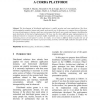Free Online Productivity Tools
i2Speak
i2Symbol
i2OCR
iTex2Img
iWeb2Print
iWeb2Shot
i2Type
iPdf2Split
iPdf2Merge
i2Bopomofo
i2Arabic
i2Style
i2Image
i2PDF
iLatex2Rtf
Sci2ools
PDPTA
2000
2000
Evaluating Multi user Distributed Action Games Architectures on a Corba Platform
The development of distributed applications is rapidly growing and some applications, like those which manipulate graphics, images and sounds, need special care. In this paper, we compare three architectures in terms of performance to design a multi user action game that heavily uses sounds and images, identifying the main drawbacks of this kind of implementation. We have run the three different game implementations in a dedicated network to measure the packets traffic, bandwidth use, events lost and data consistency on the redrawing process of each player's screen. As results, we see that to different kinds of games the use of appropriate architectures may lead to a great processing economy, network traffic reduction and gains on the user presentation quality.
| Added | 01 Nov 2010 |
| Updated | 01 Nov 2010 |
| Type | Conference |
| Year | 2000 |
| Where | PDPTA |
| Authors | Hendrik T. Macedo, Alessandro C. M. de Araújo, Dave A. T. Cavalcanti, Rogério de C. Andrade, Charles A. G. Madeira, Carlos André Guimarães Ferraz |
Comments (0)

